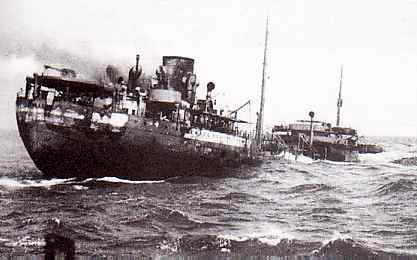Auke Visser´s Esso Scandinavian Tanker's site | home
Esso Copenhagen (I) - (1939-1942)
See also : Building & Launch of the "Esso Copenhagen (1)" & German Records off the Attack on the MS "Esso Copenhagen (1)"
The first "Esso Copenhagen (1)", was build in 1939 and lost in 1942.
"Esso Copenhagen (1)".
"Esso Copenhagen (1)".

Drawing "Esso Copenhagen (1)".

The Panames oil-tanker S/S "Esso Copenhagen (1)" of 9.245 tons sinks off the Florida coast, struck from the torpedoes of
the ( Italian submarine ) R. Smg. Torelli, to his first mission in the American seas on 25 February 1942.

The R. Smg. Torelli in Bordeaux while going through the locks leading to the tidal basin.

Silhouette of the R. Smg. Torelli
The Miramar Ship Index for "ESSO COPENHAGEN"
IDNo:
|
5613923
|
Year:
|
1939
|
Name:
|
ESSO COPENHAGEN
|
Keel:
|
|
Type:
|
Tanker
|
Launch Date:
|
31.03.1939
|
Flag:
|
PAN
|
Date of completion:
|
06.1939
|
Tons:
|
9245
|
Link:
|
-
|
DWT:
|
14825
|
Yard No:
|
642
|
Length overall:
|
Ship Design:
|
||
LPP:
|
146.2
|
Country of build:
|
DNK
|
Beam:
|
19.9
|
Builder:
|
Burmeister & Wain
|
Material of build:
|
Location of yard:
|
Copenhagen
|
|
Number of screws/Mchy/Speed(kn):
|
2D-13
|
||
Subsequent History:
-
Disposal Data:
Torpedoed and sunk (LUIGI TORELLI) 10.32 N / 53.20 W 25.02.1942 (1 dead) & sank 26.02.1942
[ Voyage Aruba-B.A., fuel oil ]
Hist19ory :
ON
|
LR/IMO
|
ID
|
Year
|
Name
|
Tons
|
Change
|
Registered Owner
|
5613923
|
1939
|
ESSO COPENHAGEN
|
9245
|
-
|
Panama Tpt., Co.
|
No sisterships.
Additional info :
Standard Oil frequently featured among leading American oil companies in the production of giant vessels,
and in 1921 they commissioned two steamers each of nearly 23,000 tons d.w.t. Built by Newport News,
they measured 572 feet by 75 feet and were named “William Rockefeller” and “John D. Archibold”.
One feature was that the raised catwalk above the deck which connected the after structure and the bridge was
not continued forward from the bridge. This lack of forward catwalk was perpetuated in subsequent vessels and
will be noticed in the illustration of the associated Panama Transport Company's “Esso Copenhagen”, built in 1939
by Burmeister & Wain in Copenhagen. This twin-screw motor tanker was 470 feet by 65 feet and had a tonnage
of 9,512 gross, 14 825 d.w.t. But previous to this time Standard Oil and its affiliates had gone in for diesel machinery
and by 1926 they had the greatest fleet of motor tankers in the world. But even prior to this time
a large hatch of standard 12,000 tonners had been ordered in Germany. Of these, the “Baltic” and the “Gedania”
of 1920 and the “Vistula” of 1921 were originally steamers but later were equipped with oil engines, whilst the
others were motor ships from the start. They were the “Phoebus” of 1923 and “Prometheus” of the following year,
and no less than six were commissioned during 1925, being “Den Haag”, “Rotterdam”, “Clio”, “Leda”, “Penelope”
and “Persephone”. Also from Germany, and in 1928, came the world's biggest motor tanker, the twin-screw
“C. O. Stillman”. Built by Bremer Vulkan, she was of 13,006 tons gross, 24,000 tons d.w.t., had a length of 585
feet and a breadth of 75 feet. In sheer size alone however, she was still outclassed by the steam tanker
“Charles G. Black” of 14,305 gross tons and which was built seven years earlier as “G. Harrison Smith” for associated
Canadian interests. The first combined oil/ore carrier, she later transferred to Standard Oil and was renamed, but
whilst retaining the unused ore compartments she was still able to offer a vast oil capacity. Sold in 1940 she
became “Venore” and was lost in 1942 when torpedoed on January 24th. The Panamanian-flag “C. O. Stillman”
was lost in similar fashion the same year when sunk off Puerto Rico on June 5th 1942.


